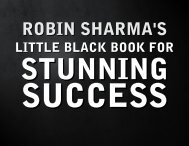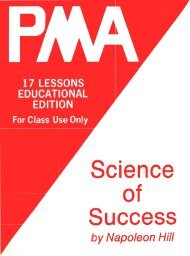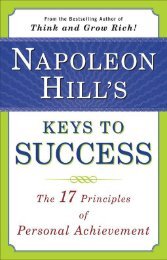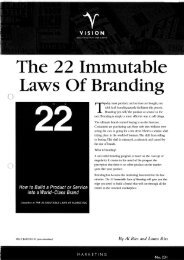The-Slight-Edge
You also want an ePaper? Increase the reach of your titles
YUMPU automatically turns print PDFs into web optimized ePapers that Google loves.
128 <strong>The</strong> <strong>Slight</strong> <strong>Edge</strong><br />
Harness the Power of Momentum<br />
Who won the race—the tortoise or the hare? We all know the answer to that<br />
one. Yet we live in a world where most everyone has come to expect instant this<br />
and instant that, and if we don’t get the results we’re after fast and faster, we quit.<br />
Get rich quick. <strong>The</strong> fast lane. That fellow standing in front of the microwave<br />
muttering, “Hurry uppp, hurry uppp ... ” Fast, faster, fastest is a strategy that<br />
will eventually take you down the <strong>Slight</strong> <strong>Edge</strong> curve.<br />
M.I.T. professor Peter Senge puts this beautifully in his best-selling business<br />
book, <strong>The</strong> Fifth Discipline—<strong>The</strong> Art & Practice of the Learning Organization:<br />
Virtually all natural systems, from ecosystems to<br />
animals to organizations, have intrinsically optimal<br />
rates of growth. <strong>The</strong> optimal rate is far less than<br />
the fastest possible growth. When growth becomes<br />
excessive—as it does in cancer—the system itself<br />
will seek to compensate by slowing down; perhaps<br />
putting the organization’s survival at risk in the<br />
process.<br />
— Peter Senge, <strong>The</strong> Fifth Discipline<br />
Have you ever witnessed something or someone that grew too fast? A<br />
business that expanded too rapidly and then self-destructed? A rock star, movie<br />
star or sports star who became a shooting star and went BOA—Burned Out on<br />
Arrival? Faster can end up being slower; too fast often puts the system’s (or the<br />
person’s) survival at risk.<br />
Dr. Senge talks about “intrinsically optimal rates of growth”; your<br />
optimal rate of growth is always served best by a<br />
step-by-step approach of constant, never-ending<br />
improvement, which lays solid foundations and<br />
builds upon them over and over. <strong>The</strong> <strong>Slight</strong> <strong>Edge</strong> is your<br />
optimal rate of growth. Simple disciplines compounded over time. That’s how<br />
the tortoise won; that’s how you get to be a winner, too.<br />
Having said that let me ask this: What is the real point of the story of the<br />
tortoise and the hare? Altogether now: Slow and steady wins the race, right? But<br />
notice something here: the point is not that there’s any special virtue to moving<br />
slowly. <strong>The</strong>re’s nothing inherently good about slowness, and it’s just as possible<br />
to move too slowly as to move too quickly.<br />
<strong>The</strong> key word in the Aesop moral is not “slow”—it’s steady.<br />
Steady wins the race. That’s the truth of it.













